.
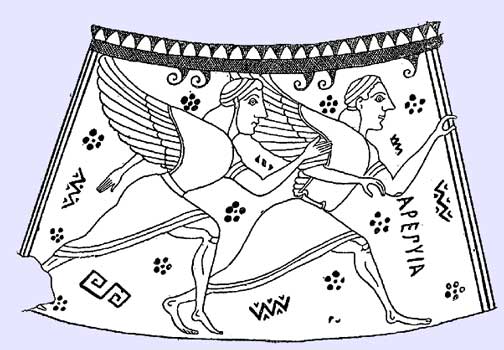
Harpies from Aegina
In Greek mythology, the Harpies (Ἅρπυιαι)("snatchers") were beautiful winged women best known for constantly stealing all food from Phineas before he could eat any of it, enforcing a punishment declared by Zeus. This led them into conflict with the Argonauts. In later traditions they were transformed into winged hags with sharp bird-talons, which is how they are popularly known.
Mythology
The Harpies were sisters of Iris, daughters of Electra and Thaumas. Hesiod (Theogony) calls them two "lovely-haired" creatures.
Phineas, a king of Thrace, had the gift of prophesy. Zeus, angry that Phineas revealed too much, punished him by putting him on an island with a buffet of food which he could never eat. The Harpies always arrived and stole the food out of his hands right before he could satisfy his hunger. This continued until the arrival of Jason and the Argonauts. The Boreads, who also could fly, succeeded in driving the Harpies away but did not kill them, as a request from the goddess of the rainbow, Iris, who promised that Phineas would not be bothered by the Harpies again. Thankful for their help, Phineas told the Argonauts how to pass the Symplegades. (Ovid XIII, 710; Virgil III, 211, 245).
The basic version of this myth, as it was retold, added details not found in earlier versions: namely, that the Harpies did not just take the food away but befouled it so it was inedible. They were soon thought as as spreaders of filth and disease, gaining their more famous monstrous appearance as well.
In this form they were agents of punishment who abducted people and tortured them on their way to Tartarus. They were vicious, cruel and violent. They lived on Strophades. They were usually seen as the personifications of the destructive nature of wind. The Harpies in this tradition, now thought of as three sisters instead of the original two, were: Aello ("storm swift"), Celaeno ("the dark") — also known as Podarge ("fleet-foot") — and Ocypete (Ὠκυπέτη) ("the swift wing").
Aeneas encountered Harpies on the Strophades as they repeatedly made off with the feast the Trojans were setting. Celaeno cursed them, saying the Trojans will be so hungry they will eat their tables before they reach the end of their journey. The Trojans fled in fear.
Heraldry
In the Middle Ages, the harpy, often called the "virgin eagle", became a popular charge in heraldry, particularly in East Frisia, seen on, among others, the coats-of-arms of Reitburg, Liechtenstein, and the Cirksenas.
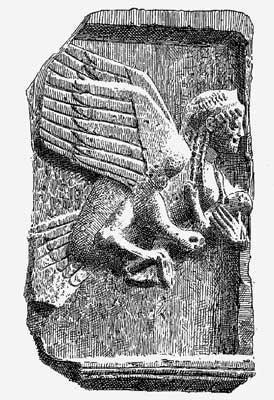
Harpy from Xanthos
Theories of origin
R.D. Barnett suggests in "Ancient Oriental Influences on Archaic Greece" — an essay in The Aegean and the Near East, Saul S. Weinberg, ed. (Locust Valley, N.Y.,1956) — that the Harpies were originally adapted from the ornaments on bronze caldrons from Urartu:
"These made such an impression in Greece that they seem to have given rise to the siren type in archaic Greek art, and as they appeared to flutter at the rim of such noble cooking vessels, apparently gave rise to the familiar Greek legend of Phineus and the Harpies, who are thus depicted in Greek art. The very name of Phineus, the victim of their persecutions, may be nothing but a corruption of the name of a king of Urartu, Ishpuinish or Ushpina (ca. 820 B.C.), who was perhaps associated by the Greek merchants with these vessels" [1] (http://rbedrosian.com/Gmyth.htm).
Other scholars point out that this theory is based upon the idea that the Harpies were bird monsters with human heads, which was not true in the original myths.
In their winged human form, the Harpies are no different from a large number of Greek divinities and as such would not need a special explanation for how they came to be. The later bird composite form is considered by most authors to have been a confusion with an early depiction of the Sirens as bird women.
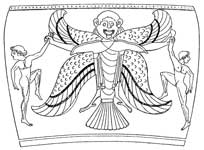
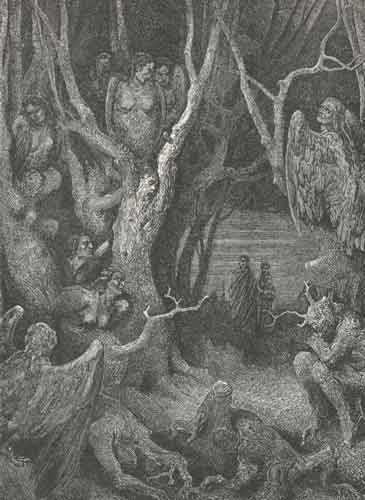
Here the brute Harpies make their nest, the same
Who from the Strophades the Trojan band
Drove with dire boding of their future woe.
Dante's Inferno
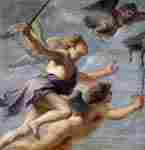
The Persecution of the Harpies, Erasmus Quellinus II
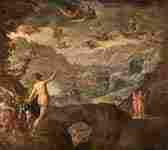
Landscape with the Expulsion of the Harpies, Paolo Fiammingo
Images of the "Harpy" Monument of Xanthus
See also
Sirens (for the original bird women in Greek mythology)
Tantalus (for another Greek character punished with never being allowed to quench his hunger or thirst)
See also : Greek Mythology. Paintings, Drawings
| Ancient Greece
Science, Technology , Medicine , Warfare, , Biographies , Life , Cities/Places/Maps , Arts , Literature , Philosophy ,Olympics, Mythology , History , Images Medieval Greece / Byzantine Empire Science, Technology, Arts, , Warfare , Literature, Biographies, Icons, History Modern Greece Cities, Islands, Regions, Fauna/Flora ,Biographies , History , Warfare, Science/Technology, Literature, Music , Arts , Film/Actors , Sport , Fashion --- |
Retrieved from "http://en.wikipedia.org"
All text is available under the terms of the GNU Free Documentation License

